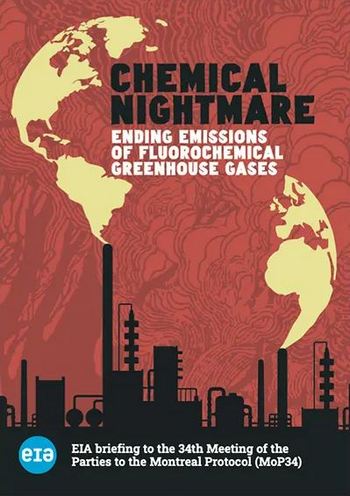EIA cites rising emissions of ozone-depleting gases and HFC-23
November 07, 2022

The 2022 Scientific Assessment of Ozone Depletion, from the World Meteorological Organization (WMO), has uncovered unexplained emissions of ozone-depleting CFCs (including 13, 112a, 113a, 114a, 115), HCFCs, and carbon tetrachloride (CCl4), as well as super greenhouse gas HFC-23, according to a new report by the Environmental Investigation Agency (EIA).
The report, “Chemical Nightmare – Ending emissions of fluorochemical greenhouse gases”, was released on October 31 at the opening of the 34th Meeting of the Parties to the Montreal Protocol (MoP34) in Montreal, Canada.
The report attributes the emissions to “feedstocks, byproducts or unknown sources.”
The EIA previously linked the source of unexpected ozone-depleting CFC-11 emissions to illegal production and use in the polyurethane foam sector in China, which had gone undetected for years by the Montreal Protocol’s existing monitoring and compliance mechanism. A nationwide enforcement effort by China in response to the findings appears to have had immediate impact, with atmospheric data indicating that CFC-11 emissions are significantly decreasing.
However, “a review of the latest scientific findings suggest that CFC-11 is just the tip of the iceberg,” says the new EIA report. “A shocking array of new chemical emissions looms large over the Montreal Protocol, challenging its reputation as the most successful environmental treaty.”
The report challenges the Montreal Protocol to develop “more robust practices for monitoring and addressing illegal production, use, trade and emissions of controlled substances. As part of this, the Parties to the Montreal Protocol must reexamine the premise of ‘insignificant’ emissions, which exempts feedstock and process agent uses from controls.”
“The alarm bells of mounting scientific evidence are impossible to ignore – the production of man-made fluorochemicals is leading to vast uncontrolled emissions of dangerous gases, which are damaging the planet’s ozone layer and exacerbating the climate emergency,” said Avipsa Mahapatra, EIA US Climate Campaign Lead,
“We urge the Montreal Protocol to take immediate action to address these emissions and to include all fluorochemical industrial processes in a comprehensive review of the Protocol’s institutions,” added Clare Perry, EIA’a U.K. Climate Campaign Leader.
The report also urged the Parties to avoid creating “new environmental problems” through the substitution of controlled substances with other potent greenhouse gases or fourth generation fluorochemicals such as HFOs, “which create new by-product and feedstock emissions and have other significant environmental impacts.”
In particular, the report referred to the creation of trifluoroacetic acid (TFA) in the atmosphere from the breakdown of HFO-1234yf and other f-gases. TFA comes to earth in rainfall and is identified as a long-lasting PFAS chemical by the OECD (Organization for Economic Co-operation and Development). “Given the longevity of FFA in the environment, a precautionary approach is clearly needed,” the report says.
The problem of by-products and feedstocks
In regard to HFC-23, which has GWP of 14,600, the report noted that it is a by-product of HCFC-22 production, which is primarily produced as a feedstock to make HFCs and their replacements, HFOs. Under the Kigali Amendment, countries with production of HCFCs or HFCs are required to ensure any by-product emissions of HFC-23 are “destroyed to the extent practicable.”
However, recent atmospheric trends for HFC-23 from 2012-18 suggest that “promised control measures put in place by major HCFC-22 producing countries have not been fully implemented, while the possibility of substantial unreported production of HCFC-22 or other sources of HFC-23 cannot be ruled out,” the EIA report says. Australian researchers have suggested that another possible source of HFC-23 are atmospheric emissions of HFO1234ze.
HFC-23 emissions reached their highest levels in history in 2018 at 15,900 ± 900 metric tons per year, the report says. “During the period 2015-17, an estimated 24,400 [metric tons] of HFC-23 were unnecessarily emitted, equivalent to around 309 million [metric tons of CO2e].” The Scientific Assessment Panel (SAP) estimates global emissions of HFC-23 in 2019 to be 17,200 ± 800 metric tons per year, compared to 2,200 metric tons per year based on reported activities, some eight times larger than expected, the report says.
Although emissions of CFC-11 have declined, emissions of CCl4, a feedstock for CFC-11, have increased, the report says. CCl4, an ozone-depleting substance with a GWP of 2,200, is also still widely used as a feedstock in the production of HFCs and HFOs, including HFO-1234yf.
Global CCl4 emissions were on average 44,000 ± 15,000 metric tons per year in both 2016 and 2020,15 while the most recent “bottom-up” estimates were 25,000 metric tons per year, the report says.
Scientists are raising concerns that reported emissions from feedstock processes are underestimated and may account for significant elevated global atmospheric levels of a number of greenhouse gases, including CCl4, CFC-113, HFC-23 and PFC-318, the report says.


